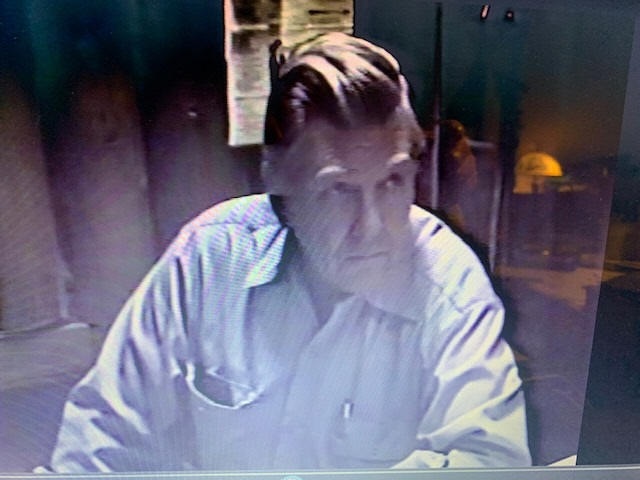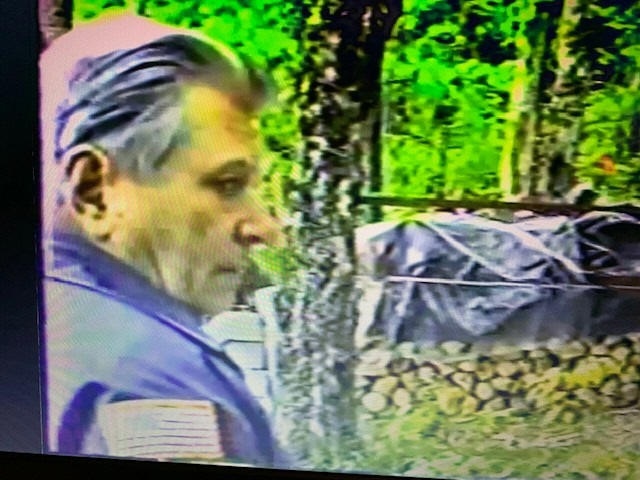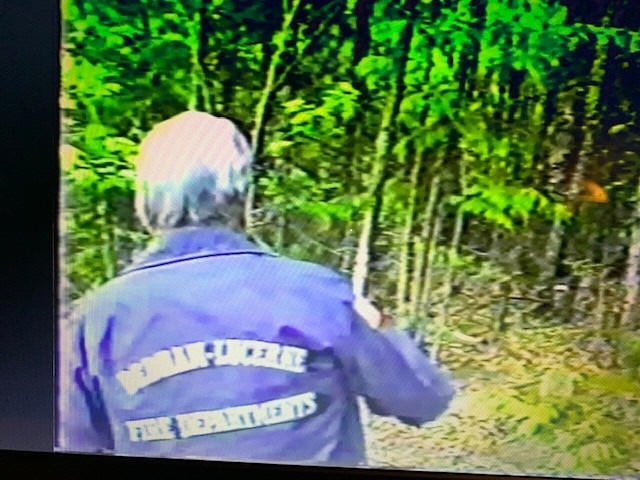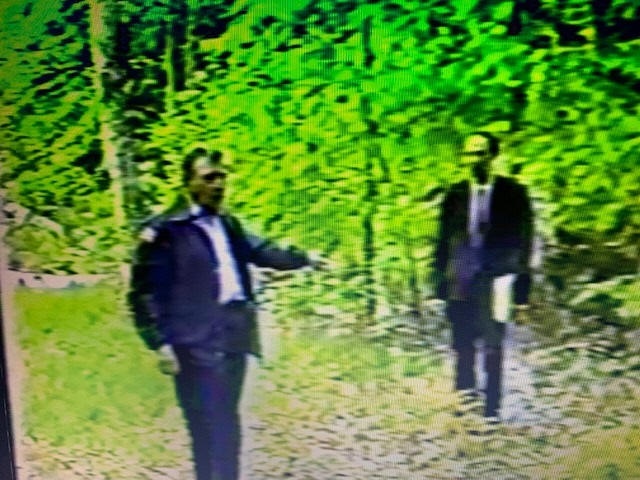Herrin said He said his years as fire chief encompassed a period of 34 years, and included 22 years as a State Fire Training Instructor. He said he hadn’t reviewed any reports or any other sorts of statements that were authored by him in preparation for his deposition. He said he did remember a fire report that he “made out relative to the February fire, I gave to one of two people and I cannot remember exactly to whom I gave it, but it was either Inspector Ricker of the fire marshal’s office or Corporal Shuman of the Maine State Police.” He said he “had never seen that report since.”
When shown a statement of what Shuman claimed Herrin told him at the murder scene on February 24, 1981 and asked to identify it, Herrin said “this would appear to be an extract of the report that I compiled immediately after the fire, which we discussed just previously. And to whom—I did not know where it went.” 1
“It appears to be a Maine State Police report of Detective Herbert Shuman in which you are quoted,” Popkin said.
Herrin was asked to briefly describe, starting at the beginning of the evening of February 17th through 18th 1981, what he recalled of the fire.
He said he recalled being awakened at 3:51 a.m. in the morning by the fire alarm telephone advising him that there was a fire in a structure on Sumac Road at Phillips Lake. The person who called in the fire alarm was also a Phillips Lake resident by the name of Joann Johnson. 2
"Ms. Johnson advised that she got up to go to the bathroom at about 3:45 a.m. She looked out the window and noticed that the [David] Dupray cottage was all on fire. ... it appeared that the trees and the whole house was fully involved in flame at the time.” He said he immediately dressed and responded. He said he arrived at 3:55 a.m. with his siren on and lights flashing (ten minutes after Ms. Johnson first saw the fire) and was the first individual to arrive on the scene. 3 He reported back to headquarters, which was at the Dedham fire station that he had arrived on the scene. He said the whole camp was on fire and his first act “was to make an eyeball survey of the area to determine the extent of the fire and what exposures, if any, were involved or would be involved.”
He said he was on the scene perhaps two minutes 4 when he “caught a view of an individual departing from the rear of the fire structure.” Herrin said he “seemed to be doing something with his hands as he was moving away from the burning structure. I would liken that to an individual who is washing their hands.”
Herrin said it was obvious to him that the individual was aware of him because “it’s not possible for five pieces of fire apparatus and red lights and sirens and the chief to arrive on the scene without an individual being aware of it, unless he was unconscious.” And at “very nearly the same time that I saw this individual, I recall seeing two 5-gallon gasoline cans that were visible at the scene. Combining the two gas cans, the individual leaving the scene, and the record extent of the burn of the structure, I immediately arrived at the decision that this was an arson fire.”
Herrin called headquarters again on his radio and asked them to get in touch with State Fire Inspector Wilbur Ricker to proceed to the incident scene as soon as possible. “In the meantime, the first due piece of apparatus had arrived on the scene, and I then became involved in laying out hose lines and getting water on the fire.”
Herrin's Assistant Chief Elmer Alto, who was also a Hancock county deputy sheriff, arrived. He called him to where he was and explained to him that he had “seen this individual leaving the scene.” He asked him to go and determine where that individual had gone. “He went out in the direction I indicated by pointing, and he picked up footprints of an individual leaving and then he disappeared from view.”
He said the cottage was constructed entirely of logs that “varied in size from probably six inches in diameter to 10 or 12 inches in diameter.” He described the fire as a “heavy fire because the roof would have been collapsing under the fuel load that was inside the structure.”
Herrin said he was called back to the radio to be advised that Inspector Ricker was on his way to the fire but had been asked to bypass it and go directly to the city of Bangor where there was a fire involving fatalities. 5
“I can’t remember when we left the scene to return to the station, but it probably would have been around six o’clock, would be my estimate, just beginning to be daylight.” That same day but later in the morning, “probably eight o’clock” Herrin and Assistant Chief Alto were back at the scene. 6
Herrin said he followed the tracks again through the woods up to a point where they suddenly made a left turn and moved down through the woods towards the old highway. Herrin said there was “no doubt in my mind” that “the tracks indicated that the individual had footwear on both feet.”
Herrin said “I doubt if Corporal Shuman saw them [Pollard’s tracks] because by the time Shuman arrived on the scene, which would have been several days [six-days] later, the snow had melted.” 7
Herrin said after he and Alto “crossed Highway M, we went down a small ditch, gully if you want to call it, up the bank approaching the present U.S. 1A, and we lost the tracks there.”8
Herrin said, “It appeared to be a direct route, there was no place where it looked like someone had milled around or sat down. “ He said “at the time I arrived on the scene, the volume of the fire that existed, I cannot picture any human being exiting from the building. Pinning it down to a definite time frame, ten minutes previous to the time I arrived on the scene, which would have been 3:45; it would have been damn difficult for a human to have exited the building at that time even. ... if he was in the structure, he was unconscious and not physically able to remove himself from the scene.”
He said he had never responded to a fire that so completely involved a structure as this one and if it began with a vapor explosion it would be less likely that someone could have gotten out or into the building after the explosion.
He said he and Elmer Alto “sat to the fire house and made out our reports at the same time, the one that I don’t know what happened to it, and he made out his, and he held it up and he said, ‘what do you think of this, Norman?’ And I says ‘have you covered all of the points?’ And he says, ‘to the best of my knowledge.’ And I says ‘okay, sign it.’ So that’s the only view I had of the report that he made. I did not read it in its entirety.” 9
Herrin said he was not there when Mike was found. He said “[MSP Corporal Allan] Jamison came here. I was sitting where I’m sitting right now and he sat over there and he said, ‘Chief, we got problems,’ and I said, ‘what’s the problem?’ He said, ‘we have found a body.’ Herrin said he couldn’t remember if the comment was made to Corporal Shuman or Inspector Ricker but it seemed to him that “Mrs. Johnson made the comment that she heard a noise like a gunshot.” 10
After doing the greater part of Herrin’s deposition at his home, we left for the murder scene where Herrin’s deposition was completed. He showed us where he had walked between the cottage and the little garage to start putting water on the fire and the direction he had seen Paul Pollard fleeing into the woods.
A cloud of black flies swarmed around us as we walked through the grass and bushes behind the remains of the burned cottage and the little garage that the fire personnel had saved. I walked to the spot that Linda had said Mike was found when we visited the murder scene after the memorial service. (How did she know the exact spot Mike had been found?) I had been here many times in the eight years since Mike’s murder. For some unknown reason it seemed to call me back again and again. But this day was different. I had brought help—or so I thought.
Years later my son Shawn and I visited the murder scene and took photos. This photo shows my son, Shawn, standing beside the little garage and in the direction that Chief Herrin said he saw Pollard running. Chief Herrin and Sheriff Alto followed Pollard’s tracks to the main highway and lost them there.
Det. Shuman and Assistant AG Thomas Goodwin accepted Pollard’s story of sitting on a rock for 4-5 hours in the cold during the month of February. Maine winters are very cold and anyone would freeze while sitting outside for hours not fully dressed.
MSP DEA Agents Shuman and Pinkham’s interviews were statements in their words of what was told to them. They could alter the information however they choose. Mike was found lying face down 6–8′ on the floor next to the outside door according to Cpl. Allan Jamison. Why was he so close to the outside door? I believe the reason he was so close to the outside door was because he was dumped there after he was shot outside. I spoke with David Dupray, owner of the cottage, and he told me that he saw blood in the woods near his cottage.



